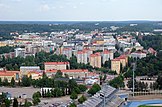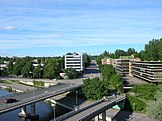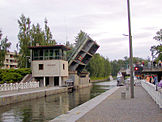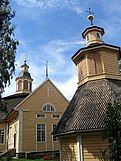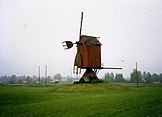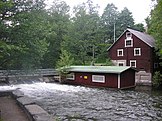Päijät-Häme
 From Wikipedia the free encyclopedia
From Wikipedia the free encyclopedia
You can help expand this article with text translated from the corresponding article in Finnish. (June 2023) Click [show] for important translation instructions.
|
Päijät-Häme Päijänne-Tavastland Päijänne Tavastia | |
|---|---|
| Region of Päijät-Häme Päijät-Hämeen maakunta (Finnish) Landskapet Päijänne-Tavastland (Swedish) | |
 Päijät-Häme on a map of Finland | |
| Country | Finland |
| Historical province | Tavastia |
| Capital | Lahti |
| Other towns | Heinola and Orimattila |
| Area | |
| • Total | 6,256.66 km2 (2,415.71 sq mi) |
| • Land | 5,126.11 km2 (1,979.20 sq mi) |
| Population (2019) | |
| • Total | 199,604 |
| • Density | 32/km2 (83/sq mi) |
| GDP | |
| • Total | €6.247 billion (2015) |
| • Per capita | €30,955 (2015) |
| ISO 3166 code | FI-16 |
| NUTS | 185 |
| Regional bird | White-backed woodpecker (Dendrocopos leucotos) |
| Regional fish | Carp bream (Abramis brama) |
| Regional flower | Cornflower (Centaurea cyanus) |
| Regional stone | Diabase |
| Regional lake | Lake Päijänne |
| Regional song | Vihreiden harjujen maa (The Land of the Green Ridges) |
| Website | paijat-hame.fi |
Päijät-Häme[2] (Finnish pronunciation: [ˈpæi̯j(ː)æt̪ˌhæme̞(ʔ)]; Swedish: Päijänne-Tavastland) is a region in Southern Finland south of the lake Päijänne. It borders the regions of Uusimaa, Kanta-Häme, Pirkanmaa, Central Finland, South Savo and Kymenlaakso. The biggest city in the region is Lahti.[3]
Päijät-Häme boasts a landscape shaped by two key features. Finland's second-largest, Lake Päijänne, dominates the region, offering a vast freshwater expanse and a vital transportation route. The Häme Ridge, a glacial remnant, adds a touch of elevation and scenic variation. Beyond these, Päijät-Häme features extensive coniferous forests. Rolling hills provide scenic views, while numerous smaller lakes and rivers create a network of waterways.[4]
History
[edit]Päijät-Häme's landscape reflects the dramatic retreat of glaciers. The last Ice Age carved the land, leaving ridges (Salpausselkä) and large lakes (Finnish Lakeland). As the ice melted, the Baltic Sea went through various stages, dramatically changing shorelines. Land rose, creating islands and eventually dry land. Human settlement followed the receding water, with the Porvoo River valley being the oldest cultural landscape. Today, Päijät-Häme boasts a unique blend of lakes, ridges, and reminders of its glacial past.[4]
After glaciers retreated 11,000 years ago, the first settlers arrived in Päijät-Häme. Birch dominated the initially barren landscape. As the climate warmed, people lived near ancient lakes and bays. By 5100 BC, the Comb Ceramic culture thrived. The arrival of the Battle Axe culture around 3200 BC brought new tools and pottery styles. During the Bronze Age (1900 BC), cremation burials and large stone cairns became common. In the Iron Age, settlements shifted to better farming areas near waterways. Viking raids and unrest marked the later Iron Age. Christianity arrived during the Crusades (1050-1300 AD).[5]
By the Middle Ages, villages dotted the shores of waterways and lakes. The 16th century saw a solidification of village life, with the most prominent settlements around Hollola, Lahti, and Nastola. The 1800s brought a boom in agriculture, with cultivated land tripling and industries like flax farming and cattle raising flourishing. Forests were mostly owned by farms, and improved transportation facilitated timber sales. Manor houses played a crucial role in rural life until World War I, with some later being divided into new farms. Today, Päijät-Häme's settlement can be divided into three zones: the sparsely populated eastern area with smaller farms and estates, the more densely populated central region with a strong presence of independent farms, and the sparsely populated north with vast forests. As transportation networks evolved, settlement patterns shifted, with Lahti emerging as the dominant population center.[6]
Villages in Päijät-Häme have a long history intertwined with the landscape. Most likely arose around the 16th century, strategically placed near ridges and waterways for easy access to water and fertile land. Water remained the primary mode of transportation for centuries, with some villages even shifting their centers to be closer to navigable routes. The arrival of railways in the 19th century revolutionized transportation, and later road networks further influenced development. Heinola, for example, benefitted from its location near the Kymijoki River, which facilitated industrial growth once railways arrived. This pattern likely mirrored itself across Päijät-Häme during the 1800s and 1900s.[7]
Heinola, founded in 1776, became the region's first city in 1839. Industrial areas grew around its center, particularly on the east and south sides. Lahti's story is tied to railways and lakeside industry. It gained market town rights in 1878 and city status in 1905. Factories like sawmills, a pulp mill, and match factories fueled Lahti's expansion. Village churches (kirkonkylät) also saw growth from the 1860s onward, spurred by relaxed land ownership laws. However, rapid expansion in some villages obscured their older features. Lahti housed sawmills, pulp mills, glass factories, and textile producers. Heinola developed sawmills, plywood, and fiberboard factories alongside metalworking. Notably, Hämeenkoski had Finland's first flax cleaning plant built in 1888. Worker housing districts accompanied industrial growth. The passage mentions both early examples and later, larger developments from the post-war period and the 1960s and 70s.[8]
Historical provinces
[edit]Heraldry
[edit]Blazon: Azure, a mermaid and in dexter chief a cuckoo close Or. In laymen's terms: The coat of arms sports a depiction of the ancient water goddess Vellamo as a mermaid, with a cuckoo.[9][10]
Municipalities
[edit]The region of Päijät-Häme consists of 10 municipalities, two of which have city status (marked in bold).
Municipalities on the map
[edit]Sub-regions
[edit] Kärkölä
Kärkölä Lahti (Lahtis)
Lahti (Lahtis) Orimattila
Orimattila Padasjoki
Padasjoki Sysmä
Sysmä
Municipalities listed
[edit]| Coat of arms | Municipality | Population | Land area (km2) | Density (/km2) | Finnish speakers | Swedish speakers | Other speakers |
|---|---|---|---|---|---|---|---|
 | Asikkala | 7,892 | 563 | 14 | 98 % | 0.2 % | 3 % |
 | Hartola | 2,519 | 543 | 5 | 97 % | 0.1 % | 3 % |
 | Heinola | 17,872 | 676 | 26 | 95 % | 0.2 % | 5 % |
 | Hollola | 22,814 | 651 | 35 | 97 % | 0.3 % | 3 % |
 | Iitti | 6,433 | 590 | 11 | 98 % | 0.2 % | 2 % |
 | Kärkölä | 4,102 | 257 | 16 | 95 % | 0.5 % | 5 % |
 | Lahti | 121,202 | 460 | 264 | 90 % | 0.4 % | 9 % |
 | Orimattila | 15,649 | 785 | 20 | 96 % | 0.6 % | 4 % |
 | Padasjoki | 2,711 | 523 | 5 | 97 % | 0.4 % | 3 % |
 | Sysmä | 3,448 | 667 | 5 | 98 % | 0.3 % | 3 % |
| Total | 204,642 | 5,715 | 36 | 92 % | 0.4 % | 7 % |
Former municipalities
[edit]
 Artjärvi (Artsjö)
Artjärvi (Artsjö) - Consolidated with the town of Orimattila in 2011.[11]
 Hämeenkoski
Hämeenkoski  Heinolan maalaiskunta (Heinola landskommun)
Heinolan maalaiskunta (Heinola landskommun)  Nastola
Nastola
- Until 2021, Iitti was part of the Kymenlaakso region before it became part of Päijät-Häme.[15]
Politics
[edit]Results of the 2019 Finnish parliamentary election in Päijät-Häme:
- Social Democratic Party 23.28%
- Finns Party 22.10%
- National Coalition Party 19.43%
- Centre Party 9.94%
- Green League 8.82%
- Left Alliance 6.12%
- Christian Democrats 6.12%
- Movement Now 1.64%
- Seven Star Movement 0.40%
- Blue Reform 0.38%
- Swedish People's Party of Finland 0.29%
- Other parties 1.48%
See also
[edit]Gallery
[edit]- Medieval church in Hollola
- A view of Lahti centre
- Lake Päijänne in Sysmä
- Heinola town centre
- Lahti Market Place with the City Hall by Eliel Saarinen in the background
- Virenoja Rapids and ruins of an old mill, Orimattila
- Hartola Church
- The radio masts in Lahti, symbols for the city
- Vääksy Canal, Asikkala
- Rural landscape in Orimattila
- Nastola Church
- Rural landscape in Kärkölä
- The Tähtiniemi Bridge in Heinola
- The celebrated Sibelius Hall is the heart of Lahti's cultural life
- Ski jumping hills in Lahti; also a venue for Ski Jumping WC
- A rock cleft in Hollola
- The Gothic Revival church in Kärkölä
- Lake Vesijärvi in Asikkala
- A windmill in Hartola
- A typical traditional Tavastian village view, Orimattila
- National romantic municipal house in Hollola
- Architecture in Lahti
- Pyhäniemi Manor, Hollola
- An old mill at River Vääksynjoki, Asikkala
References
[edit]- ^ Regions and Cities > Regional Statistics > Regional Economy > Regional GDP per Capita, OECD.Stats. Accessed on 16 November 2018.
- ^ "Luokitus: Maakunnat 2022 | Tilastokeskus".
- ^ "EURES - Labour market information - Päijät-Häme - European Commission". ec.europa.eu. Retrieved 2016-08-09.
- ^ a b Aarrevaara, Eeva; Uronen, Carita; Vuorinen, Tapani (2006). "Päijät-Hämeen maisemaselvitys" (PDF). Lahden ammattikorkeakoulun julkaisu (in Finnish). Sarja Artikkelikokoelmat, raportit ja muut ajankohtaiset julkaisut, osa 22. Lahti: LAB University of Applied Sciences (Lahden ammattikorkeakoulu): 8–9. ISSN 1457-8328. Retrieved 2024-04-22.
- ^ Aarrevaara, Eeva; Uronen, Carita; Vuorinen, Tapani (2006). "Päijät-Hämeen maisemaselvitys" (PDF). Lahden ammattikorkeakoulun julkaisu (in Finnish). Sarja Artikkelikokoelmat, raportit ja muut ajankohtaiset julkaisut, osa 22. Lahti: LAB University of Applied Sciences (Lahden ammattikorkeakoulu): 10–11. ISSN 1457-8328. Retrieved 2024-04-22.
- ^ Aarrevaara, Eeva; Uronen, Carita; Vuorinen, Tapani (2006). "Päijät-Hämeen maisemaselvitys" (PDF). Lahden ammattikorkeakoulun julkaisu (in Finnish). Sarja Artikkelikokoelmat, raportit ja muut ajankohtaiset julkaisut, osa 22. Lahti: LAB University of Applied Sciences (Lahden ammattikorkeakoulu): 14–19. ISSN 1457-8328. Retrieved 2024-04-22.
- ^ Aarrevaara, Eeva; Uronen, Carita; Vuorinen, Tapani (2006). "Päijät-Hämeen maisemaselvitys" (PDF). Lahden ammattikorkeakoulun julkaisu (in Finnish). Sarja Artikkelikokoelmat, raportit ja muut ajankohtaiset julkaisut, osa 22. Lahti: LAB University of Applied Sciences (Lahden ammattikorkeakoulu): 54–59. ISSN 1457-8328. Retrieved 2024-04-22.
- ^ Aarrevaara, Eeva; Uronen, Carita; Vuorinen, Tapani (2006). "Päijät-Hämeen maisemaselvitys" (PDF). Lahden ammattikorkeakoulun julkaisu (in Finnish). Sarja Artikkelikokoelmat, raportit ja muut ajankohtaiset julkaisut, osa 22. Lahti: LAB University of Applied Sciences (Lahden ammattikorkeakoulu): 20–21. ISSN 1457-8328. Retrieved 2024-04-22.
- ^ Päijät-Häme – Kuntaliitto (in Finnish)
- ^ Maakuntatunnukset – Päijät-Hämeen liitto (in Finnish)
- ^ "Artjärvi ja Orimattila yhteen 2011". Yle (in Finnish). 22 March 2010. Retrieved 7 August 2022.
- ^ Tuomisto, Emmi (30 December 2016). "Hämeenkosken hyvä henki kukoistaa kuntaliitoksen jälkeenkin". Etelä-Suomen Sanomat (in Finnish). Archived from the original on 7 August 2022. Retrieved 7 August 2022.
- ^ Räty, Nina (26 June 1996). "Heinolat yhdistyvät sittenkin - ja vauhdilla KHO kumosi lääninoikeuden päätöksen tasa-arvopykälien rikkomisesta". Helsingin Sanomat (in Finnish). Helsinki: Sanoma Media Finland Oy. Retrieved 7 August 2022.
- ^ Uuskallio, Vili (29 December 2016). ""Lahden ja Nastolan liitoksesta seurannut jotain hyvääkin"". Etelä-Suomen Sanomat (in Finnish). Retrieved 7 August 2022.
- ^ Korhonen, Antti-Jussi (31 December 2020). "Iitti vaihtaa maakuntaa huomenna – kaikkiaan viisi kuntaa vaihtaa maakuntaa". Yle (in Finnish). Retrieved 26 September 2022.




